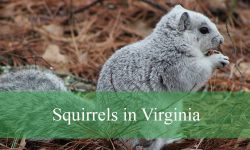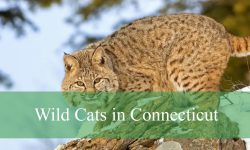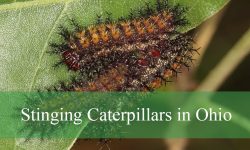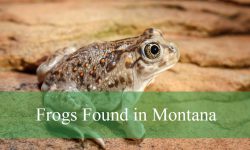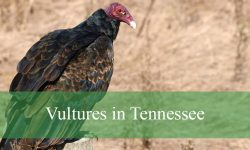Colorado is home to a wide variety of lizards that live in many different habitats, from deserts and grasslands to rocky mountainsides. These reptiles come in many shapes, sizes, and colors, making them interesting creatures to learn about and observe.
This article explores 20 common lizard species found in Colorado. It includes clear pictures and helpful identification tips for each species, along with information about their behavior, diet, and habitats. This guide is perfect for nature lovers and anyone interested in discovering the fascinating lizards of Colorado.
Species of Lizards Found in Colorado
Common Collared Lizard (Crotaphytus collaris)
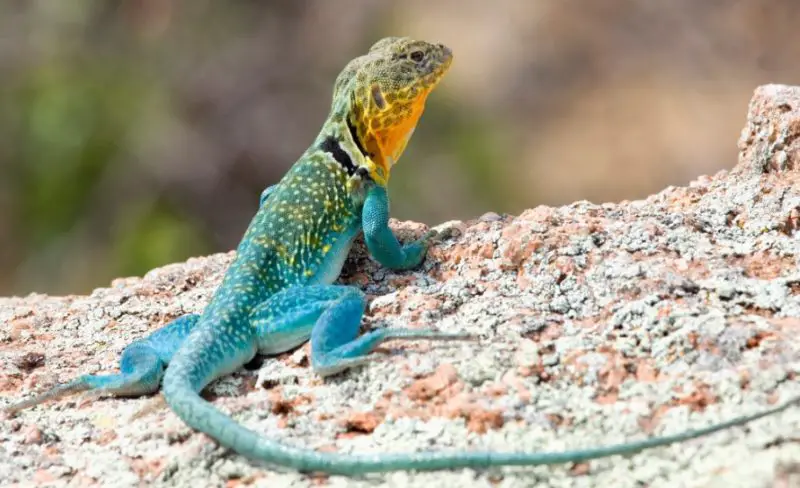
The Common Collared Lizard is one of the most visually striking reptiles in Colorado, easily recognized by its vivid green to yellowish body, large head, and the two black “collar” bands around its neck. Adults can grow up to 15 inches long, with nearly two-thirds of that length being tail. Males are typically brighter than females, especially during the breeding season, when their colors become even more intense.
This species is known for its bold and active behavior. Unlike many other lizards that scurry away, collared lizards often run on their hind legs to escape predators—giving them a dinosaur-like gait. They are territorial and aggressive hunters, often seen basking on rocks where they keep a lookout for both prey and rivals.
Common Collared Lizards are carnivorous, feeding on insects, other lizards, and occasionally small rodents. They prefer dry, rocky areas such as canyons, mesas, and foothills, particularly in southeastern Colorado. A fun fact: this lizard is the official state reptile of Oklahoma, a neighboring state where it also thrives.
Long-nosed Leopard Lizard (Gambelia wislizenii)
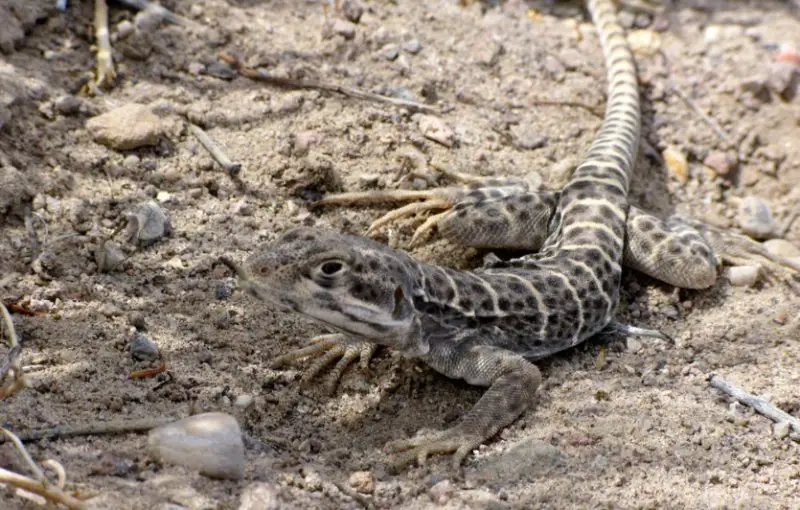
The Long-nosed Leopard Lizard stands out with its long snout, large head, and spotted body. Its cream or light gray color is decorated with dark brown spots, giving it a leopard-like pattern. It can grow between 8 and 13 inches long, including its tail. Juveniles often display reddish bars on their backs and tails, which fade as they mature.
These lizards are sit-and-wait predators, meaning they often stay motionless and ambush prey with a quick burst of speed. They are solitary and mostly active during the day, especially in warmer months. When threatened, they may puff up their bodies or open their mouths wide to intimidate potential predators.
Long-nosed Leopard Lizards consume a variety of insects, spiders, and even smaller lizards. Occasionally, they’ll eat plant material. In Colorado, they are mostly found in desert shrublands and arid plains in the western part of the state. An interesting fact is that females can change color during breeding season, with their undersides developing reddish-orange patches.
Lesser Earless Lizard (Holbrookia maculata)
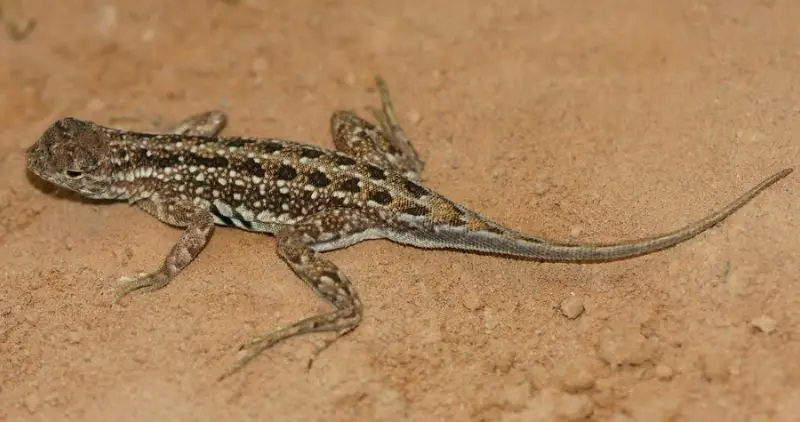
The Lesser Earless Lizard is a small, slender species with a smooth, scaleless ear opening—hence its name. It typically ranges from 4 to 5.5 inches long, with sandy or grayish-brown coloring and light spots or bars on the back. Its coloration helps it blend perfectly into its surroundings, making it hard to spot.
This lizard is very fast and agile, often darting quickly across open ground to evade predators. It prefers flat, open habitats like sandy prairies, shortgrass plains, and dune systems. During the hottest parts of the day, it will often burrow into the soil or take shelter under rocks to avoid overheating.
Lesser Earless Lizards feed primarily on small insects such as ants, beetles, and grasshoppers. They are commonly found in southeastern Colorado, where dry soils and sparse vegetation provide ideal conditions. A fun fact: this species lacks external ear openings, which helps prevent sand from entering while it burrows.
Texas Horned Lizard (Phrynosoma cornutum)

The Texas Horned Lizard is famous for its toad-like body, spiny appearance, and short tail. Growing up to 5 inches long, it is covered in sharp horns on the head and spines along the body. Its brown and tan mottled coloring helps it blend into dry, sandy environments.
This species is known for its unique defensive behaviors. When threatened, it can flatten its body to appear larger, hiss, or even squirt blood from the corners of its eyes—a rare ability used to deter predators. It is generally slow-moving and spends much of its time basking or staying still to remain camouflaged.
Texas Horned Lizards feed almost exclusively on ants, particularly harvester ants, though they may also eat beetles and grasshoppers. In Colorado, they occur mostly in the southeastern corner, in open plains and grasslands. Fun fact: due to habitat loss and pesticide use, their populations have declined, and they are considered a species of concern in some areas.
Greater Short-horned Lizard (Phrynosoma hernandesi)
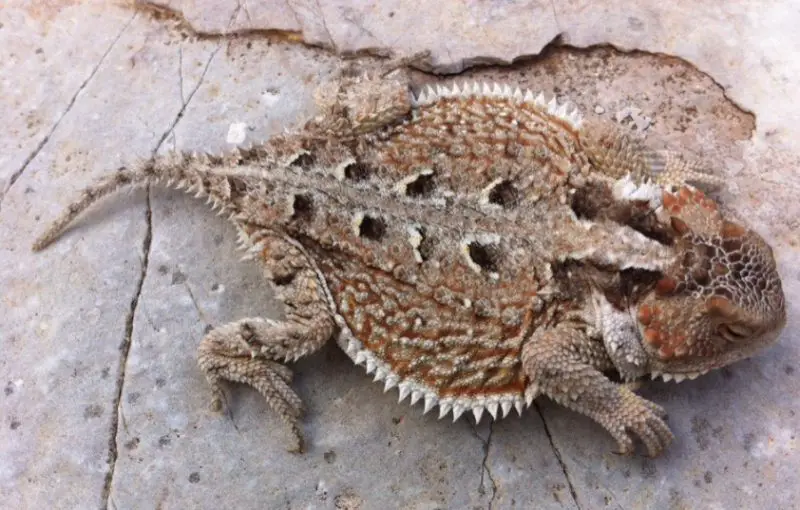
The Greater Short-horned Lizard is a squat, broad-bodied reptile with short horns and spiny scales across its back and sides. It is usually gray, reddish-brown, or light tan, depending on its environment, and grows to about 4 to 5 inches in length. Despite its small size, it has a fierce, dragon-like appearance.
This lizard is primarily found in higher elevations compared to other horned lizards. It inhabits forest edges, sagebrush flats, and grasslands across central and western Colorado. It is diurnal and often basks during the morning before retreating into vegetation or burrows to avoid extreme heat.
Like its Texas relative, the Greater Short-horned Lizard eats mainly ants but will also consume beetles, spiders, and other small invertebrates. It has similar defensive traits, including the ability to squirt blood from its eyes if threatened. A fun fact: it can survive in cooler, mountainous regions where few other lizards live, thanks to its adaptability and preference for rocky outcrops.
Roundtail Horned Lizard (Phrynosoma modestum)
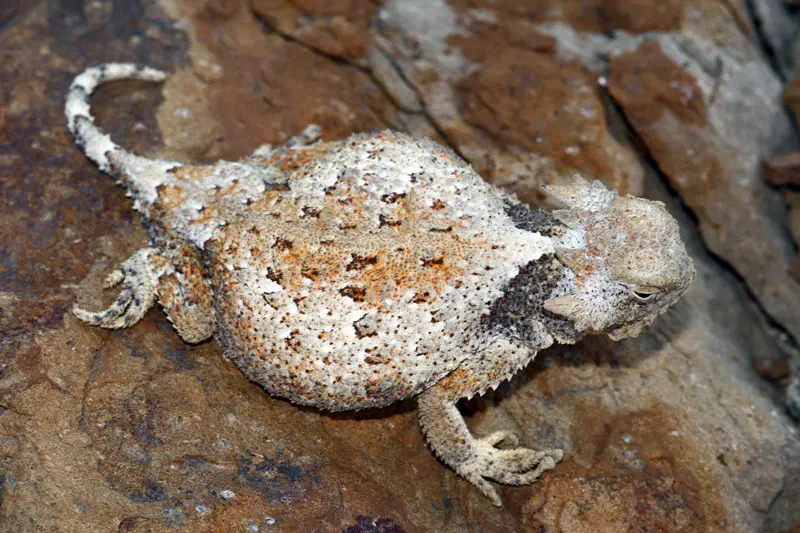
The Roundtail Horned Lizard is a small, flat-bodied lizard easily distinguished by its rounded tail, in contrast to the spiky tails of other horned lizards. Its body is pale gray or tan with dark blotches, helping it camouflage against sandy or gravelly soil. Adults usually measure around 3 to 4 inches in length, making it one of the smaller horned lizards in the region.
This species is shy and well-adapted to remaining hidden. When threatened, it will lie flat against the ground, making itself nearly invisible. Unlike some of its relatives, it rarely displays aggressive defense behaviors like blood-squirting. Instead, it relies on stillness and camouflage to avoid predators.
Roundtail Horned Lizards feed primarily on ants, but they will also eat beetles and other small insects. In Colorado, they are found in the extreme southern and southeastern parts of the state, especially in dry grasslands and scrub deserts. A fun fact: this lizard’s tail is perfectly rounded, which helps distinguish it from all other horned lizard species in North America.
Sagebrush Lizard (Sceloporus graciosus)
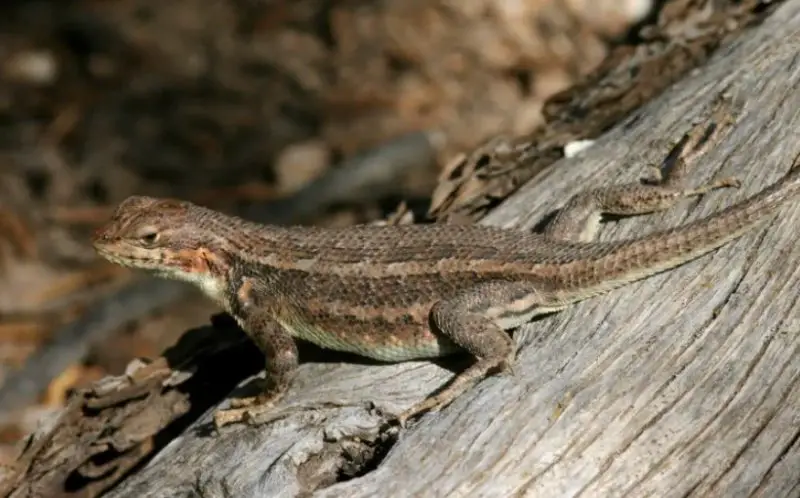
The Sagebrush Lizard is a small, agile reptile with a rough, scaly body and a pointed snout. Its coloration ranges from gray to brown, often with darker crossbands or wavy patterns down the back. Adult lizards typically grow to about 4 to 5 inches in length, including the tail.
These lizards are active during the day and are most often seen basking on rocks, logs, or fence posts in the morning sun. Males display brilliant blue patches on their bellies and throats during the breeding season, which they use in courtship displays and territorial behaviors. They are quick to flee when approached, often diving into crevices or under vegetation.
Sagebrush Lizards primarily feed on small insects and spiders, which they actively hunt. In Colorado, they inhabit dry, open habitats at mid to high elevations, particularly in sagebrush-covered hills and open woodlands. A fun fact: they are often mistaken for the similar Western Fence Lizard, but the two are separated by range and subtle physical differences.
Desert Spiny Lizard (Sceloporus magister)
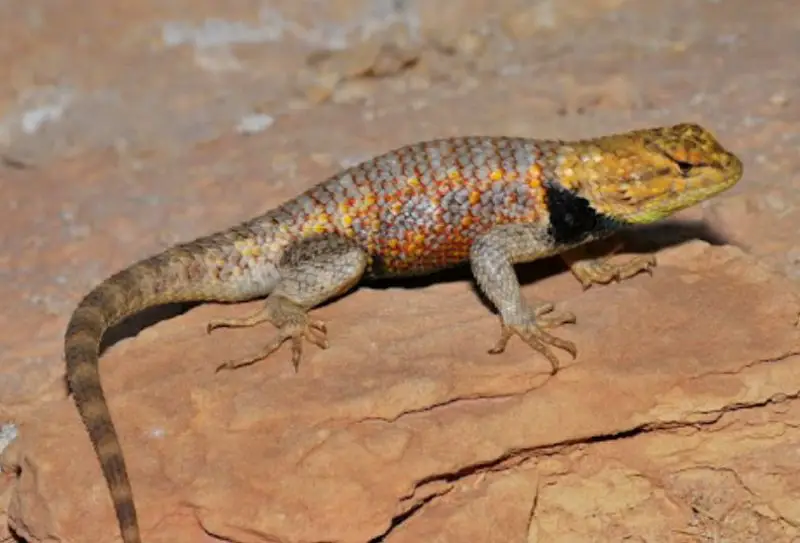
The Desert Spiny Lizard is one of the larger lizards in the region, growing up to 10 inches long. It has rough, keeled scales and a thick, sturdy body. Its coloration varies from gray to brown to purplish, often with darker bands and shiny blue patches on the sides and belly, especially in males.
These lizards are bold and territorial. Males perform head-bobbing and push-up displays to warn rivals or attract mates. Desert Spiny Lizards are active in warm temperatures and can often be seen basking on rocks or walls. When approached, they will often retreat quickly but may return to their perch after a short time.
Their diet consists mainly of insects like beetles, ants, and grasshoppers, as well as occasional plant matter. In Colorado, they are found primarily in the southwestern corner, where deserts, canyons, and rocky outcrops offer the warm, arid conditions they prefer. A fun fact: they can change color slightly to regulate their body temperature—darker in the morning, lighter in the heat of the day.
Eastern Fence Lizard (Sceloporus undulatus)
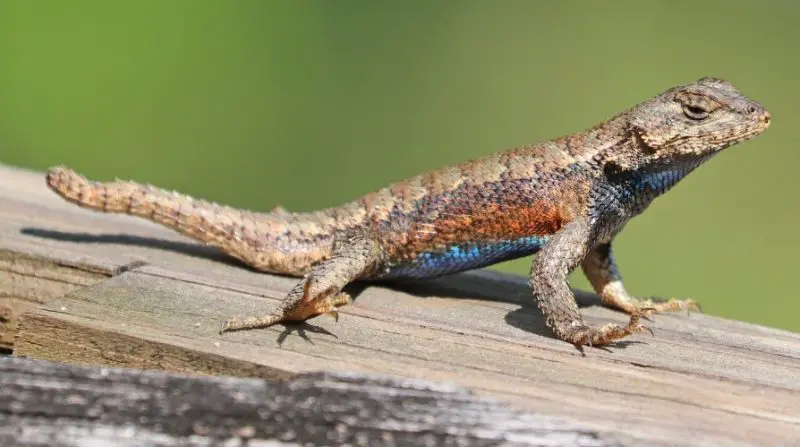
The Eastern Fence Lizard is a medium-sized lizard with a rough, spiny texture and a broad head. It is usually brown or gray with a series of wavy, dark lines across its back and tail. Adult length ranges from 4 to 7.5 inches. Males exhibit bright blue patches on their throat and belly, which become more vibrant during the breeding season.
This lizard is a strong climber and often found on logs, fences, or tree trunks. It is diurnal and basks during the morning hours before becoming more active in foraging and territorial displays. Males are known for their push-up displays used to establish dominance or attract females.
Eastern Fence Lizards feed on ants, beetles, caterpillars, and spiders. In Colorado, they are most commonly found in the southeastern portion, particularly in woodland edges and rocky clearings. A fun fact: these lizards have evolved resistance to fire ant venom in parts of their range where fire ants are invasive, showcasing remarkable adaptability.
Ornate Tree Lizard (Urosaurus ornatus)
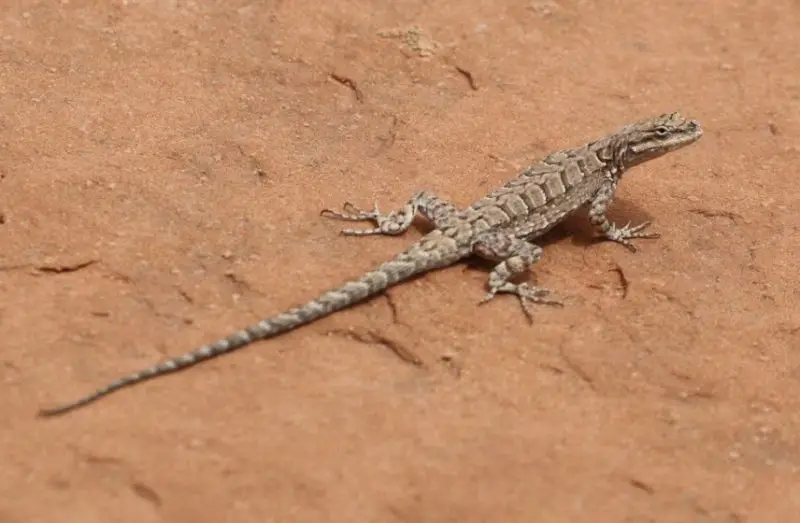
The Ornate Tree Lizard is a small, slender lizard with a long tail and fine scales. It usually grows to about 4 to 5 inches in length. Its coloration is highly variable but often includes shades of brown or olive, with speckled patterns and sometimes orange or turquoise markings. Males often show a blue or green belly patch.
This species is an excellent climber and spends much of its time in low shrubs, trees, or on vertical surfaces like rock walls. It is active during the day and prefers warm, sunny spots for basking. Ornate Tree Lizards are quick and alert, escaping danger by dashing into cracks or up trees.
Their diet includes ants, beetles, flies, and small spiders. In Colorado, they are mainly found in the southwestern regions where desert canyons and rocky outcrops are common. A fun fact: males come in different “morphs” with varying throat colors, each type exhibiting different mating strategies—a rare trait among reptiles.
Common Side-blotched Lizard (Uta stansburiana)
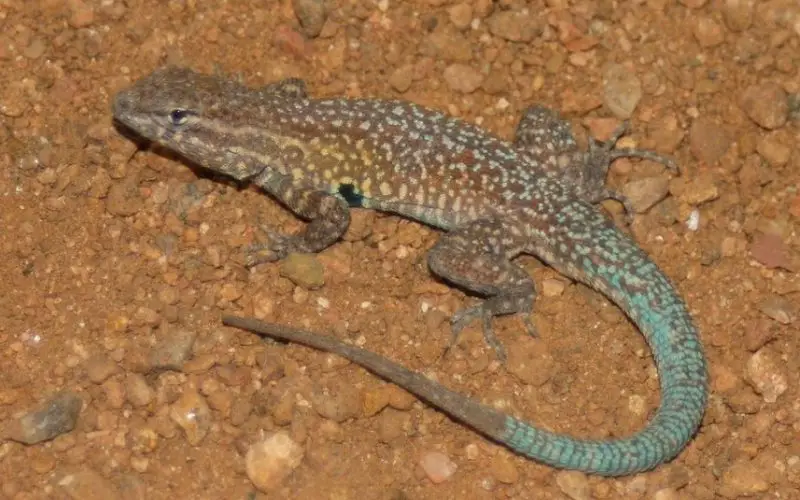
The Common Side-blotched Lizard is a small, quick reptile typically measuring 4 to 6 inches long. It has a tan to grayish-brown body with tiny scales and a distinct dark blotch just behind each front limb—its namesake feature. Males often show bright blue or orange throat colors during the breeding season, while females are more subdued.
This lizard is known for its agility and speed. It is highly active during the day, darting across the ground in search of food or mates. It occupies open, sunlit areas such as rocky hillsides, grasslands, and desert flats. Males are territorial and may engage in head-bobbing or push-up displays to ward off rivals.
Side-blotched Lizards eat small insects like ants, flies, and beetles, as well as spiders. In Colorado, they are found mostly in the western and southwestern parts of the state. A fun fact: male side-blotched lizards have three throat color morphs—orange, blue, and yellow—each linked to a different mating strategy, creating a natural “rock-paper-scissors” dynamic in evolution.
Great Plains Skink (Plestiodon obsoletus)

The Great Plains Skink is one of the largest skinks in North America, reaching lengths of 9 to 13 inches. It has smooth, glossy scales with a gray or tan background and darker edges that create a subtle checkered appearance. Juveniles are black with bright blue tails, making them easy to distinguish from adults.
This species is secretive but active during the day, often found under rocks, logs, or debris. It is a ground-dweller and prefers areas near water sources, such as stream banks, moist canyons, and grasslands. When threatened, it will quickly retreat to cover or drop its tail to distract predators.
Great Plains Skinks eat a variety of invertebrates, including grasshoppers, beetles, crickets, and spiders. In Colorado, they are mostly found in the southeastern plains and foothills. A fun fact: despite their name, they are excellent climbers and swimmers, showing a high degree of adaptability for a ground-based lizard.
Variable Skink (Plestiodon multivirgatus epipleurotus)
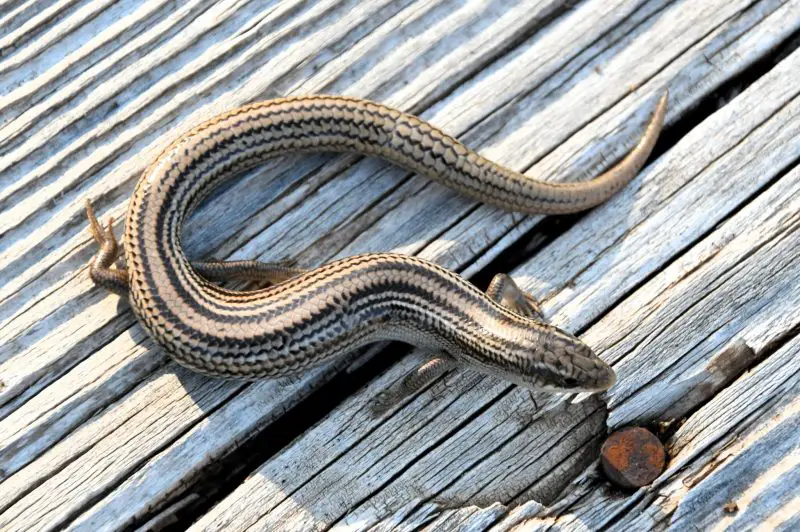
The Variable Skink is a subspecies of the Many-lined Skink, known for its smooth scales and thin, elongated body. Adults typically reach 5 to 7 inches in length and have narrow light stripes running along a brown or gray back. As its name implies, its coloration and patterning can vary widely, even within the same population.
This skink is diurnal and prefers loose, sandy soils in grasslands, shrublands, or near rock outcrops. It often hides under flat rocks or logs and emerges to bask or hunt in warm daylight hours. When alarmed, it may retreat quickly or use its detachable tail to distract predators.
Variable Skinks feed on insects, spiders, and other small invertebrates. In Colorado, they are found in the southeastern and south-central regions, often in transitional zones between prairie and canyon habitats. A fun fact: this skink has one of the most variable appearances of any North American skink, which can make identification in the field a challenge.
Many-lined Skink (Plestiodon multivirgatus multivirgatus)
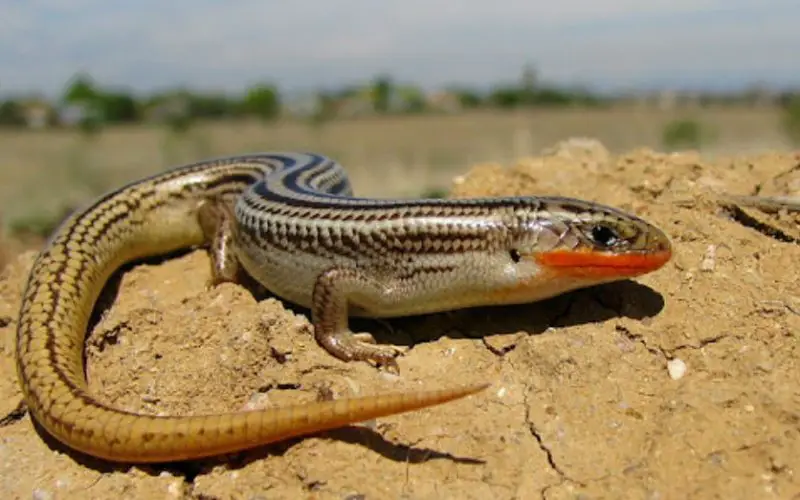
The Many-lined Skink is a sleek, slender lizard with numerous narrow stripes running from its head to the tip of its tail. It usually grows to about 4.5 to 6 inches in length. The body color is generally light brown or olive, and the stripes are white or pale yellow, creating a distinctive lined pattern.
This skink is secretive and prefers to stay hidden in loose soil, under logs, or beneath flat rocks. It is active during the daytime, especially in warm weather, and will often bask briefly before scurrying back into cover. Though it may look delicate, it is surprisingly resilient in harsh habitats.
Many-lined Skinks feed on ants, crickets, caterpillars, and other small arthropods. They are common across much of central and eastern Colorado, especially in sandy or loamy soils. A fun fact: these skinks exhibit tail autotomy, meaning they can drop their tails to escape predators—and the tails continue to wriggle to distract attackers.
Colorado Checkered Whiptail (Aspidoscelis neotesselatus)
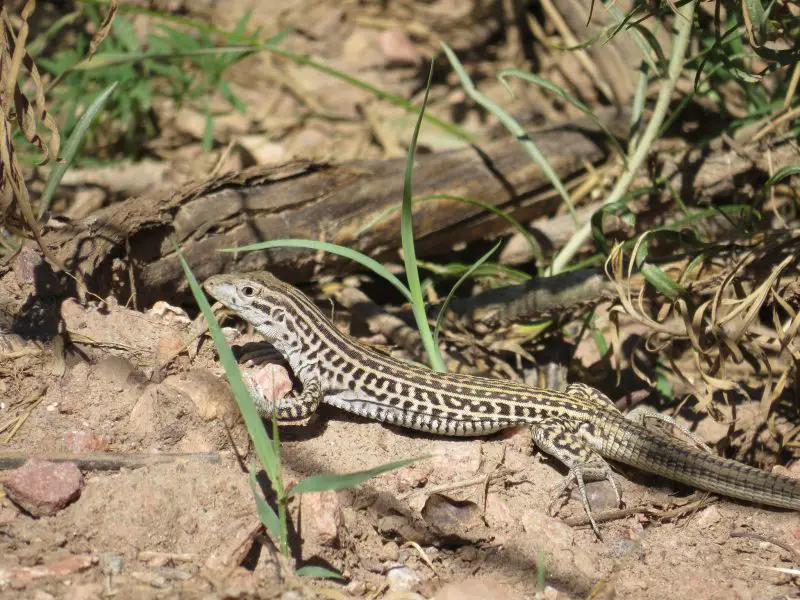
The Colorado Checkered Whiptail is a slim, long-tailed lizard with an intricate pattern of dark checks and pale stripes along its body. Adults average between 8 to 12 inches long, with the tail often twice the length of the body. Their background color is typically brown, tan, or olive with a series of distinct light lines running down the back and sides.
This species is incredibly fast and energetic. It prefers hot, open habitats like rocky canyons, desert grasslands, and shrub-covered hillsides. Whiptails are active foragers that rarely sit still, constantly searching for food with quick, jerky movements. They are often seen darting under rocks or vegetation when startled.
Colorado Checkered Whiptails feed on ants, termites, beetles, and spiders. Interestingly, this species is all-female and reproduces through parthenogenesis, meaning females lay eggs without mating. Endemic to Colorado, it is found primarily in the southeastern parts of the state. A fun fact: despite being a relatively recent discovery (identified in 1997), it’s already recognized as one of the few vertebrate species unique to Colorado.
Six-lined Racerunner (Aspidoscelis sexlineata)
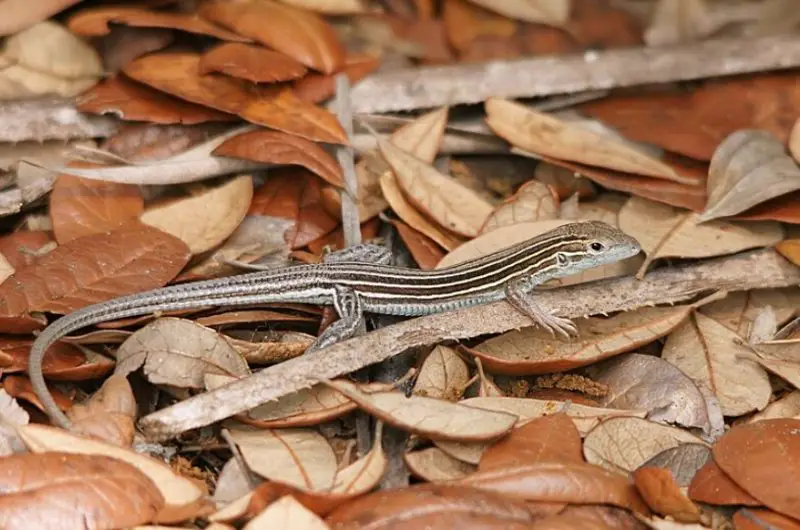
The Six-lined Racerunner is a slender, streamlined lizard known for its incredible speed and six bright yellow or greenish stripes running down its black or dark brown body. Adults typically grow between 6 to 9 inches long, with a long, whiplike tail making up more than half their length. Juveniles often show a more vibrant blue tail that fades with age.
This species is highly active and extremely fast, capable of sprinting in short bursts to escape predators or chase prey. It prefers open, sunny habitats with loose soil such as grasslands, sandy plains, or open woodlands. Racerunners spend most of their day foraging and basking, only retreating during the hottest part of the day or in poor weather.
Six-lined Racerunners feed primarily on insects, including ants, beetles, grasshoppers, and spiders. In Colorado, they are found mainly in the eastern plains and southeastern regions. A fun fact: these lizards can run up to 18 miles per hour, making them one of the fastest reptiles in North America.
Common Checkered Whiptail (Aspidoscelis tesselata)
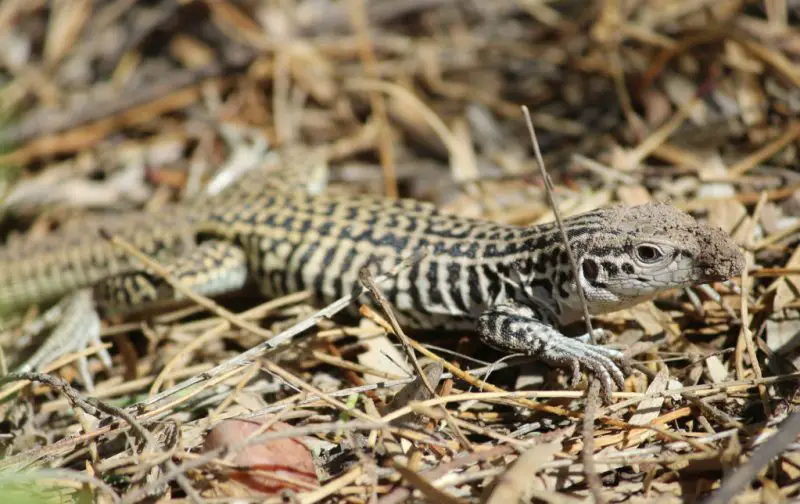
The Common Checkered Whiptail is a long-bodied, slender lizard with a complex pattern of black and white checkered spots and stripes across its back and tail. Adults typically reach 8 to 12 inches in length. Their coloration provides excellent camouflage in dry, rocky environments where they are often found.
Like other whiptails, this species is very active and forages constantly throughout the day. It avoids predators by darting quickly into crevices or beneath vegetation. The Common Checkered Whiptail is all-female and reproduces through parthenogenesis, meaning no male is needed for egg-laying, which is common in several whiptail species.
Its diet consists mainly of insects, spiders, and other small arthropods. In Colorado, it occurs in the southern and southeastern portions, especially in arid canyons and grasslands. A fun fact: despite being entirely female, this species maintains genetic diversity through complex chromosomal mechanisms developed over evolutionary time.
Western Whiptail (Aspidoscelis tigris)

The Western Whiptail is a lean, fast-moving lizard with a long, tapering tail and finely spotted or striped body. Adults can grow between 8 and 13 inches long. Their coloring varies widely but often includes tan, gray, or olive with a mix of dark flecks or stripes and pale lines running along the body.
These lizards are agile and alert, frequently seen scurrying across rocky or sandy terrain in search of prey. They are solitary and spend much of their time basking or actively foraging during the day. Their powerful legs and long tail help them navigate swiftly through complex desert environments.
Western Whiptails feed on ants, beetles, grasshoppers, and caterpillars. In Colorado, they are found mostly in the southwestern corner, inhabiting desert shrublands, rocky outcrops, and canyon floors. A fun fact: the Western Whiptail is one of the most widespread whiptail species in the western U.S., with several regional subspecies adapted to different habitats.
Plateau Striped Whiptail (Aspidoscelis velox)
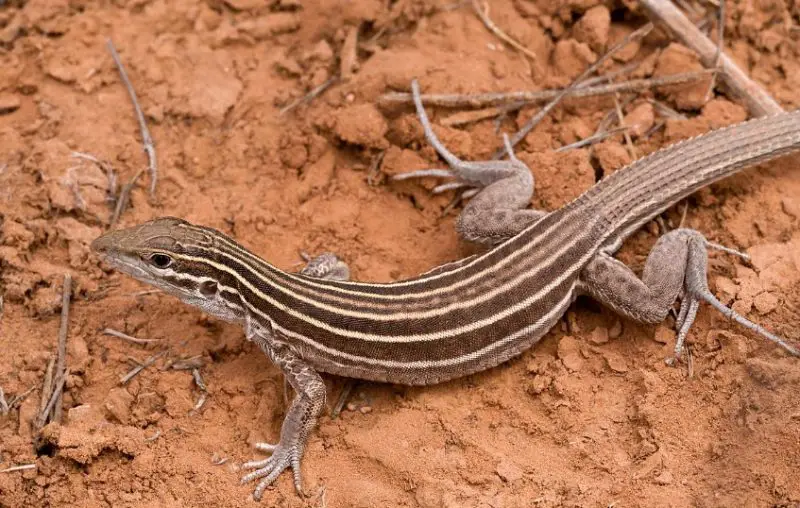
The Plateau Striped Whiptail is a small, slender lizard with a smooth body and bold, light stripes running down a dark brown or black background. Adults usually range from 6 to 9 inches in length. It has a glossy appearance, and juveniles may have blue tails similar to other whiptails.
This lizard is diurnal and highly active, spending much of its time foraging for food. It prefers dry, rocky plateaus, shrublands, and canyon environments. When threatened, it uses rapid movements to escape and is often difficult to catch due to its speed and agility.
Plateau Striped Whiptails eat ants, termites, beetles, spiders, and other small invertebrates. This species is also parthenogenetic and composed entirely of females. In Colorado, it’s mostly found in the southwestern and south-central areas where rocky and arid landscapes provide ideal conditions. A fun fact: despite lacking males, this species maintains stable populations and thrives in harsh, high-elevation environments.
San Luis Valley Short-horned Lizard (Phrynosoma diminutum)
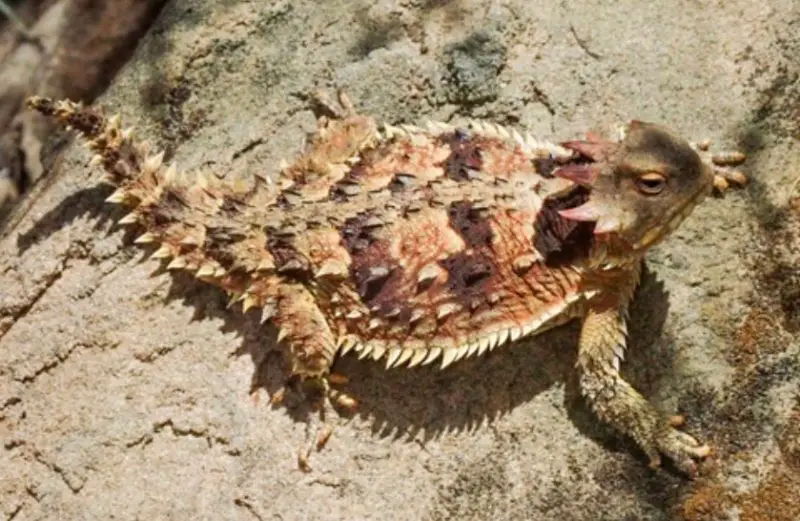
The San Luis Valley Short-horned Lizard is a tiny, flat-bodied species unique to southern Colorado. Adults are among the smallest horned lizards in North America, typically reaching only 2 to 2.5 inches in length. Their body is round, with short spines on the head and rough, pebbly scales across the back. Their coloring is usually muted—gray, brown, or reddish—blending well with the dry, rocky soil of their native habitat.
This elusive species is adapted to cool, high-altitude environments and is primarily found in the San Luis Valley. It prefers open sagebrush plains, grasslands, and rocky flats with loose, sandy soils. The lizard is most active during warm daylight hours, often basking briefly before retreating to shelter under rocks or into shallow burrows. It is generally solitary and highly sedentary compared to faster, more agile lizard species.
The San Luis Valley Short-horned Lizard feeds mainly on ants, especially harvester ants, along with small beetles and other arthropods. Its slow-moving, sit-and-wait hunting strategy is well-suited for catching prey that comes within close range. A fun fact: this species is so localized and specialized that it was only formally described in 1997 and is found exclusively in the San Luis Valley—nowhere else on Earth.
FAQs About Lizards in Colorado
What types of lizards are commonly found in Colorado?
Colorado is home to over 20 species of lizards, including horned lizards, whiptails, skinks, and fence lizards. Some common examples include the Six-lined Racerunner, Greater Short-horned Lizard, Common Checkered Whiptail, and Sagebrush Lizard. Each species is adapted to different environments, ranging from desert canyons to high-altitude grasslands.
Are lizards in Colorado dangerous to humans?
No, lizards in Colorado are not dangerous to humans. They are non-venomous, shy, and tend to avoid human contact. Most species will flee quickly when approached. They play a beneficial role in the ecosystem by controlling insect populations.
Where can I see lizards in Colorado?
You can find lizards in dry, sunny habitats such as grasslands, desert shrublands, rocky slopes, and canyons. The southeastern and southwestern parts of the state offer the best chances for spotting species like the Texas Horned Lizard or Western Whiptail. Some species also occur in the foothills and lower mountain zones.
When are lizards most active in Colorado?
Lizards in Colorado are most active during warm months, typically from late April through September. They are diurnal, meaning they are active during the day. Peak activity is often in the morning and late afternoon when temperatures are more moderate.
What do Colorado lizards eat?
Most lizards in Colorado are insectivores. Their diet includes ants, beetles, grasshoppers, spiders, and other small arthropods. Some species, like the horned lizards, specialize in eating ants, while whiptails and racerunners consume a wider range of fast-moving insects.
Do lizards hibernate in Colorado?
Yes, lizards in Colorado enter a period of dormancy known as brumation during the winter. As ectothermic animals, they cannot tolerate freezing temperatures. They burrow underground or seek shelter in crevices to survive the cold months.
Are there any endangered lizards in Colorado?
Yes, a few lizard species in Colorado are considered vulnerable or species of concern. For example, the San Luis Valley Short-horned Lizard (Phrynosoma diminutum) has a very limited range and is under close observation due to habitat sensitivity. Conservation efforts help monitor and protect these localized populations.
Can I keep wild Colorado lizards as pets?
It is not recommended to capture wild lizards for pets, and in some cases, it may be illegal without proper permits. Wild-caught lizards can suffer in captivity, and removing them disrupts the local ecosystem. Instead, consider adopting captive-bred lizards from reputable breeders if you’re interested in reptile keeping.
How do lizards in Colorado defend themselves?
Lizards use a variety of defense strategies including speed, camouflage, tail autotomy (dropping the tail), and puffing up their bodies. Some horned lizards can even squirt blood from their eyes as a last resort. Most rely on fleeing or hiding to avoid predators.
Are lizards important to Colorado’s ecosystem?
Yes, lizards are a vital part of Colorado’s natural ecosystems. They help regulate insect populations and serve as prey for birds, snakes, and mammals. Their presence indicates a healthy, balanced environment. Protecting their habitats ensures biodiversity and ecological stability.

